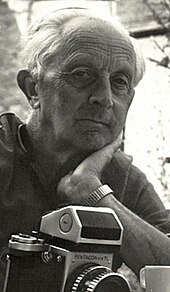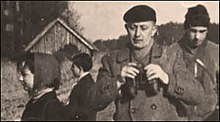Konrad Banz
Konrad Banz (born February 14, 1914 in Berlin ; † October 19, 1984 ibid) was a German educator and naturalist .
Life
Banz has been working with the well-known ornithologists Otto Uttendörfer and Otto Schnurre since the early 1930s . As their young student, he provided essential basic material for studies on the biology of birds of prey and owls in the Mark Brandenburg. After the Second World War he was taken prisoner of war in Louisiana , USA . He used the time of captivity to set up his own zoological collection.
As a scientist, Banz has made a major contribution to the fundamental revision of Robert März 's "Gewöll- und Rupfungskunde". Banz has completely re-incorporated the identification keys for fish and reptiles via skull and pharynx bones as well as scales made of wool . The work provides information about the feeding habits of birds of prey . Banz laid the foundations for nature and species protection , especially the protection of birds of prey. After his death, the March collection of feathers, bones and drawings that he had kept and supplemented in Tierpark Berlin was given to the Naumann Museum Köthen. His insect collection, which was part of the large collection of the Tierpark Berlin, went to the Senckenberg German Entomological Institute in Müncheberg (Brandenburg). Other parts of the collections were transferred to the Museum für Naturkunde Berlin .
Educational work
Konrad Banz has rendered outstanding services to educating young people in a humanistic worldview and in a love of the natural sciences. From 1949 Konrad Banz worked as one of two employees in the biology department in the Central House of Young Pioneers . This was housed in the house on the Parkaue in Berlin's Lichtenberg district, which still exists today as the “Theater an der Parkaue”. Before it was taken over into German administration, it was set up by the Soviet administration in 1948 as the children's house . Extracurricular working groups for young naturalists, artists, technicians, radio operators and other areas of interest were set up there. From the end of the 1950s, Banz was again active as a teacher in the Weissensee district, when so-called stations for young naturalists were set up in the East Berlin districts . In the Falkenberger Strasse nature reserve in Berlin-Weißensee, he worked until 1967 as the head of the “Young Natural Scientists” group. After its dissolution in the early 1970s, Banz was invited by Heinrich Dathe , director of the zoo in Berlin-Friedrichsfelde, to continue his work group in the rooms of the zoo in Berlin . The zoo school and later the youth club in Tierpark Berlin were set up there in 1965, the educational function of which was guaranteed by an educational department. In this department, Banz was one of six educators. While the zoo school took on the professional training to become zoo animal keepers, at the same time the youth club offered extra-curricular leisure activities for nature-loving children and young people. The youth club was housed in the ticket office ("Alte Wache") of the zoo at the historic portal to Friedrichsfelde Palace. At the end of the 1980s, over 300 pupils and young people in 30 groups were being looked after at the same time. Depending on their orientation or specialization, each of these groups dealt with subjects from ornithology , entomology , field herpetology , animal drawing, and botany . The working groups were also led by volunteer youth, most of whom had previously been members of a working group in the youth club.
Young people were able to take part in excursions from Banz. These excursions usually took place one to two weeks during the school holidays. These young people then presented the research results in exhibitions in the Alfred Brehm House . It was Banz's merit, through his specialist and factual activity, to introduce the students to targeted scientific work outside of political education. Several hundred students of Banz were able to be educated in the course of the three decades of his work through his interdisciplinary knowledge of indigenous fauna and flora. Many of these students now work in scientific professions or in nature conservation institutions and associations. Tierpark Berlin-Friedrichsfelde GmbH, founded in 1991, tried to carry on this tradition under the name “Jugendclub Tierpark Berlin”. After former colleagues from Banz had retired due to old age, the current youth club was without any guidance from employed zoo educators. Only three volunteer youth groups still exist. The educational department founded in 1965, in which Banz worked as a zoo pedagogue until his death, was continued as a zoo school until mid-2004. Due to the cancellation of teaching positions, Tierpark Berlin, as a renowned and internationally recognized institution - like the Berlin Zoological Garden - can only fulfill its educational and teaching duties to a limited extent.
Fonts
- Further evidence of the ear lark (Eremophila alpestris L.) as overwintering inland. In: Ornithology. 11. 1965, pp. 340-341.
- Biological excursions and exhibitions as highlights of the youth club work in Tierpark Berlin. In: Milu. 4 1978, pp. 236-238.
- (with Heinz M. Gawlik) On the food ecology of the long-eared owl (Asio otus L.) within the Berlin urban area. In: Ornithology. 28 (5) 1982, pp. 275-288.
- Record of the spatula skua, Stercorarius pomarinus Temminck, for Brandenburg. In: Ornithology. 29. 1983, pp. 321-322.
- In memory of Dr Otto Schnurre. In: Ornithology. 30. 1984, pp. 69-70.
- Robert March: Growing and plucking customer. 3rd edition, newly edited by Konrad Banz. Akademie Verlag, Berlin 1987, ISBN 3-05500157-5 .
literature
- Otto Uttendörfer: Observations on the feeding of our day birds of prey and owls in 1931. In: Journ. Orn. 80, 1932, pp. 284-293.
- Otto Uttendörfer: Observations on the feeding of our day birds of prey and owls in 1932. In: Journ. Orn. 82, 1934, pp. 210-221.
- Otto Schnurre: About some changes in the population of Brandenburg birds of prey. Journ. Orn. 94, Hft. 1/2 1953, pp. 94-98.
- Hans-Jörg Zott: Konrad Banz - 70 years. In: Pica. 8. 1983, pp. 88-90.
- Hans-Jörg Zott: We mourn Konrad Banz. In: Pica. 9. 1984, p. 112.
- Marianne Dunsing: On the work of EVA FEIGE and KONRAD BANZ in the sense of a nature-loving education of children after World War II in Berlin. Cond. Bot. Ver. Berlin Brandenburg 139. 2006, pp. 409-411.
Web links
- Banzianer - youth work, list of educational trips
- Banzschule - online collections designed for environmental education
| personal data | |
|---|---|
| SURNAME | Banz, Konrad |
| BRIEF DESCRIPTION | German educator and naturalist |
| DATE OF BIRTH | February 14, 1914 |
| PLACE OF BIRTH | Berlin |
| DATE OF DEATH | October 19, 1984 |
| Place of death | Berlin |

